Dynamic Design’s MK2-XLR digital cable, SE-XLR interconnects, Lotus MK2 AC powercord and Spirit MK2 digital AC powercord
|
Dynamic Design’s MK2-XLR digital cable, SE-XLR interconnects, Lotus MK2 AC powercord and Spirit MK2 digital AC powercord |
|
Sheer Musical Enjoyment |
|
|
|
December, 2011 |
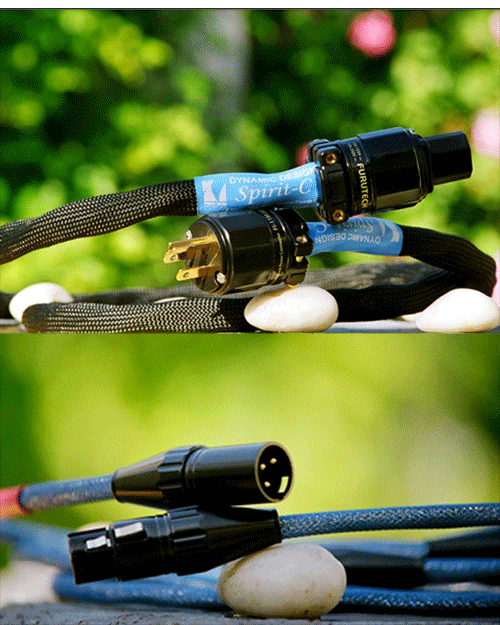
Olufemi Sonuga, chief designer for Dynamic Design cables, made the point during a telephone conversation that his designs are conceived of and intended to be used as a complete package. I find this attitude totally understandable—I would feel precisely the same way were I a cable designer. Certainly changing one or two cables is going to make an audible difference—indeed many reviews and home trials are carried out in this fashion—but ultimately it is not going to let you hear what the cable system is capable of. And that, of course, is precisely what the designer wants you to hear. The word “synergy” springs to mind, a word that if not vexed, perhaps ought to be.
On the other hand, there is an impracticable side to the expectation of auditioning a complete cable system. Not all that many of us have eight or ten thousand dollars in mad money just lying around in order purchase a complete Dynamic Design cable package (even though Dynamic Design offers a 30 day trial period). Many of us would prefer a taster, as it were, to get an idea what a cable series “sounds like.” Some of us have to start small, a pair of interconnects here, a power cord there. In other words, of necessity we evaluate cables as a less than complete package. This is probably more common than the other way ’round. That is my situation too. It is not the designer’s ideal, but it is realistic and, I trust, worthwhile.
For logistic and safety reasons I am unable to include the Dynamic Design loudspeaker cables in this review. (I get away with running my own loudspeaker cable across the living room floor under a rug because I use Nordost Flatline Gold, but thicker cables pose a potential tripping hazard, as well as an endurance test for the cables. And a room rearrangement to accommodate thicker cables is impractical and acoustically undesirable.) So, I have installed everything besides loudspeaker cables, the MK2-XLR digital cable, type SE-XLR interconnect cables, two Lotus MK2 15A AC cords and one Spirit MK2 digital AC cord. Price-wise this set of wires is a few hundreds more costly than my current reference cables, not a big difference in cost. In any case, at this price point we’re playing with the big boys (though by no means have we plumbed the depths of audiophile debt). All connectors are made by Furutech. The XLR cables are finished with what appear to be models FP601/602 which feature Teflon insulation, black-painted brass shells, gold plated phosphor-bronze pins, and cryogenic treatment.
Those of you familiar with my reviews will be aware that I devote a lot of space to technical matters. I am very interested in the theory, materials and experimentation that went into a final design. When I contacted him for detailed information about these matters, Mr Sonuga wrote that, “We at Dynamic Design believe that purchase decisions should be made based on careful consideration of a designer’s design philosophy and listening tests in one’s own system, not on generalizations, which is all that can be accomplished with detailed material lists anyway.” I don’t fully agree with this conclusion. While detailed material and construction information may be nonessential to a purchase decision, such information is interesting in itself. To me in any case. True enough, in deciding what to buy, one can easily get lost in technical matters, matters which may be irrelevant to the vital issue of how it sounds and how much musical enjoyment it provides. I remember encountering a similar attitude many years ago when I questioned Mark Levinson about an early Red Rose amplifier design: in that case too my curiosity was destined to not be satisfied.
The Dynamic Design site provides a number of PDFs summarizing aspects of their design philosophy and execution which center around shielding, bandwidth and dielectric materials. There is, alas, no white paper consolidating and discussing such matters in detail. But there are a congruity of factors among their various cables, whether intended to carry low-level AC (audio signals), low-level digital data (S/PDIF signals), or high-level AC (power). Once upon a time we may have conceived of power source and power cables as performing independently of audio signals, but upon closer examination the same characteristics desirable in a signal cable are also generally desirable in a power cable. If power cable shielding is inadequate, no matter how well designed the power supply, noise can end up riding on the DC and it will modulate the audio signal. As well, artifacts of electromagnetic noise, even SHF noise, can generate frequencies that show up in the audible range. If a power cable dielectric performs poorly it can have an audible effect on instantaneous changes of current flow. Because isolation between power and audio is never absolute, the audio signal in effect modulates current draw, which in turn can effect the linearity of amplification and switching devices further down the line.
What about insulation? Insulation is a necessary evil—you can’t make a practical cable without it, but it inevitably distorts the original signal waveform. Except a vacuum, of course, which is a perfect insulator with a dielectric constant of 1.0—there can be no distortion due to the capacitance effects of a dielectric. On the other hand, every material is imperfect in this regard and has a dielectric constant >1.0. Dielectric constant is an relative indicator of an insulator’s capacity to take and hold a charge, to act like a capacitor. Dielectric constants greater than 1.0 entail a theoretical two-fold source of distortion: the charge cycle can distort the amplitude of the waveform of the original signal, and the discharge cycle can produce audible time smear effects.
“The irony about dielectrics,” Dynamic Design states in a technical note, “is that, at times, the lossiest ones produce distortions that are very enjoyable to listen to.” If you recall the tubes versus transistor debates of yesteryear, tubes were said to have even-order harmonic distortions which were regarded as euphonic, i.e., agreeable to the ear. It’s refreshing that this manufacturer notes that euphony is not the same thing as accuracy. Different dielectric materials can slow energy propagation in a conductor by different factors, usually expressed as a percentage of the speed of light. In other words, they can add time smear. Dynamic Design states that the expense of designing and implementing cutting-edge dielectrics to minimize time smear accounts for a good part of the cost of their cables. I’d sure like to know more about the materials they do use!
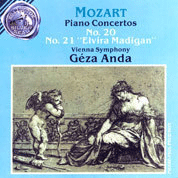 Mozart: Piano Concertos No. 20, 21, Géza Anda, pianist/conductor, Vienna Symphony Orchestra (RCA 60484-2-RV). There are some among the ranks of cognoscenti and would-be cognoscenti who feel that Géza Anda’s interpretation of Mozart’s piano concertos is unsurpassed. I don’t know about that—Clara Haskil springs to mind—but certainly there is a sense of a very special affinity between composer and performer/conductor. Rereading Maynard Solomon’s biography Mozart: A Life while listening to his music has been a profound and powerful experience. Perhaps all art partakes of the mysterious and miraculous, but Mozart’s art is in a league of its own. This is the purest music ever written. And the two concertos on this CD are among his supreme creations, as well as among his most universally loved. The Dynamic Design cables are immensely satisfying in their presentation of this music, very neutral, with an amazing amount of detailed ambient retrieval. Indeed, I have rarely heard such a convincing image and soundstage. The opening strings in the Allegro of Concerto No. 20 are simply beautiful, naturally and effortlessly arrayed across the stage with the clear sense of depth and physicality. As well the opening notes of the Andante are almost vanishingly delicate yet harmonically and dynamically rich. Altogether a lovely presentation.
Mozart: Piano Concertos No. 20, 21, Géza Anda, pianist/conductor, Vienna Symphony Orchestra (RCA 60484-2-RV). There are some among the ranks of cognoscenti and would-be cognoscenti who feel that Géza Anda’s interpretation of Mozart’s piano concertos is unsurpassed. I don’t know about that—Clara Haskil springs to mind—but certainly there is a sense of a very special affinity between composer and performer/conductor. Rereading Maynard Solomon’s biography Mozart: A Life while listening to his music has been a profound and powerful experience. Perhaps all art partakes of the mysterious and miraculous, but Mozart’s art is in a league of its own. This is the purest music ever written. And the two concertos on this CD are among his supreme creations, as well as among his most universally loved. The Dynamic Design cables are immensely satisfying in their presentation of this music, very neutral, with an amazing amount of detailed ambient retrieval. Indeed, I have rarely heard such a convincing image and soundstage. The opening strings in the Allegro of Concerto No. 20 are simply beautiful, naturally and effortlessly arrayed across the stage with the clear sense of depth and physicality. As well the opening notes of the Andante are almost vanishingly delicate yet harmonically and dynamically rich. Altogether a lovely presentation.
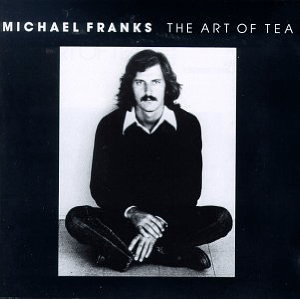 Michael Franks: The Art of Tea(Reprise Records 2230-2). I first heard Michael Franks on a Los Angeles jazz station, at a more laid-back and optimistic period of our cultural history. This is one of those recordings that always sounds good, a well-recorded small band, electric guitar, sax, drums, electric keyboard, Mr Franks of course, precise, stable soundstage and image, a lot of that ‘in the room’ feeling. I’ve heard this CD through the numerous changes in my stereo, but I’ve never heard anything quite like this, quite this present, this pure, this spacious. And with that strong impression of tonal neutrality. There is a relaxed quality to the sound—like putting on a comfortable shirt—an indefinable something washing over the senses like a gentle wave, a lucid sense of reality. I’ve simply never enjoyed this album more, or felt more excitement in it’s presentation.
Michael Franks: The Art of Tea(Reprise Records 2230-2). I first heard Michael Franks on a Los Angeles jazz station, at a more laid-back and optimistic period of our cultural history. This is one of those recordings that always sounds good, a well-recorded small band, electric guitar, sax, drums, electric keyboard, Mr Franks of course, precise, stable soundstage and image, a lot of that ‘in the room’ feeling. I’ve heard this CD through the numerous changes in my stereo, but I’ve never heard anything quite like this, quite this present, this pure, this spacious. And with that strong impression of tonal neutrality. There is a relaxed quality to the sound—like putting on a comfortable shirt—an indefinable something washing over the senses like a gentle wave, a lucid sense of reality. I’ve simply never enjoyed this album more, or felt more excitement in it’s presentation.
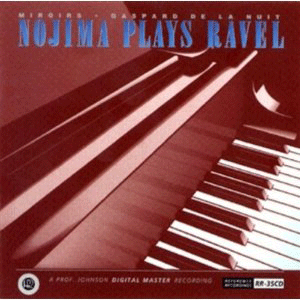 Nojima Plays Revel (Reference Recordings RR-35CD). This recording, which I’ve used in one or two other reviews, is unique in that I was told details of the studio setup by the engineer himself, Keith O. Johnson. With the Dynamic Design cables there is a limpid purity to the sound, a clarity and articulation that are utterly captivating. Not only is the position of the piano correct and precise, but there is a flood of ambient and mechanical detail. Nojima’s breathtaking and nuanced precision, Ravel’s magical and lush evocations, have never sounded quite this good. One of the pieces on this CD, Gaspard de la Nuit, is based on a set of poems by Aloysius Bertrand and it would take a fellow poet to do verbal justice to the music. I think no composer, not even Debussy, wrote so intimately and with such emotional precision for the pianoforte. The richness, dynamics and rhythmic pace presented by the Dynamic Design cables is quite wonderful.
Nojima Plays Revel (Reference Recordings RR-35CD). This recording, which I’ve used in one or two other reviews, is unique in that I was told details of the studio setup by the engineer himself, Keith O. Johnson. With the Dynamic Design cables there is a limpid purity to the sound, a clarity and articulation that are utterly captivating. Not only is the position of the piano correct and precise, but there is a flood of ambient and mechanical detail. Nojima’s breathtaking and nuanced precision, Ravel’s magical and lush evocations, have never sounded quite this good. One of the pieces on this CD, Gaspard de la Nuit, is based on a set of poems by Aloysius Bertrand and it would take a fellow poet to do verbal justice to the music. I think no composer, not even Debussy, wrote so intimately and with such emotional precision for the pianoforte. The richness, dynamics and rhythmic pace presented by the Dynamic Design cables is quite wonderful.
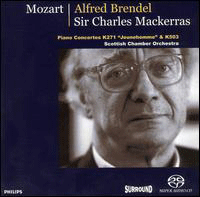 Mozart: K.271 & K.503, Alfred Brendel, piano, Sir Charles Mackerras conducting the Scottish Chamber Orchestra (Philips 5188425). Alfred Brendel has called K.271 “one of the wonders of the world…Mozart’s first great masterpiece.” I would not usually twice include a particular composer in a review, but until a couple of weeks ago I had never heard K.271 (called theJeunehomme). In those two weeks I must have played it fifty times. I can’t get enough of it. One of the wonders of the world indeed. Brendel’s playing is punctilious and fleet, noble, unhurried like a silken landscape. We are clearly in the presence of a particularly devoted and skillful interpreter of this work, which was composed when Mozart was 22. It is very nicely engineered recording, and through the Dynamic Design cables there is a wonderful dimensionality and spaciousness to the sound. The venue is very live and exciting. I don’t know that I’ve heard a more realistic presentation of a piano and orchestra.
Mozart: K.271 & K.503, Alfred Brendel, piano, Sir Charles Mackerras conducting the Scottish Chamber Orchestra (Philips 5188425). Alfred Brendel has called K.271 “one of the wonders of the world…Mozart’s first great masterpiece.” I would not usually twice include a particular composer in a review, but until a couple of weeks ago I had never heard K.271 (called theJeunehomme). In those two weeks I must have played it fifty times. I can’t get enough of it. One of the wonders of the world indeed. Brendel’s playing is punctilious and fleet, noble, unhurried like a silken landscape. We are clearly in the presence of a particularly devoted and skillful interpreter of this work, which was composed when Mozart was 22. It is very nicely engineered recording, and through the Dynamic Design cables there is a wonderful dimensionality and spaciousness to the sound. The venue is very live and exciting. I don’t know that I’ve heard a more realistic presentation of a piano and orchestra.
Some very fine cables, digital, interconnect and power, have cycled through my stereo over the years and, frankly, I would be hard pressed to say cable X is fabulous but cable Y is just so-so. Maybe I’ve just been very lucky, but in my opinion all these cables have been carefully thought out and constructed in order to implement and fulfill a particular design philosophy. All of them have sounded good relative to one another, albeit with sometimes subtle and sometimes more obvious differences. In this rather brief review I have pointed out a number of salient characteristics of this partial set of Dynamic Design cables. What I must reiterate is perhaps the most important thing an audiophile can say about any component: the sheer musical enjoyment it provides. In the months they have been in the stereo I have been partaking of an auditory feast. Although I am a little disappointed not to have learned more about the materials and construction of Dynamic Design cables, I have found them to be a convincing source of musical pleasure and among the very best I’ve heard. For anyone in the cable market, I unhesitatingly urge an audition of these beauties from Dynamic Design.

![]()
Specifications:
Interconnect cable, Type-SE XLR, 1 meter, $1800
Digital cable, MK2 XLR, 1.5 meter, $1000
Power cord, Lotus 15A, 6 feet, $1000
Power cord (digital), Spirit MK2, 6 feet, $1200
Company:
Dynamic Design Audio Visual
5341 North Sawyer Avenue
Chicago, Illinois 60625
Website: www.dynamicdesignav.com
![]()
Don’t forget to bookmark us! (CTRL-SHFT-D)
Stereo Times Masthead
Publisher/Founder
Clement Perry
Editor
Dave Thomas
Senior Editors
Frank Alles, Mike Girardi, Key Kim, Russell Lichter, Terry London, Moreno Mitchell, Paul Szabady, Bill Wells, Mike Wright, Stephen Yan, and Rob Dockery
Current Contributors
David Abramson, Tim Barrall, Dave Allison, Ron Cook, Lewis Dardick, Dan Secula, Don Shaulis, Greg Simmons, Eric Teh, Greg Voth, Richard Willie, Ed Van Winkle, and Rob Dockery
Music Reviewers:
Carlos Sanchez, John Jonczyk, John Sprung and Russell Lichter
Site Management Clement Perry
Ad Designer: Martin Perry





Be the first to comment on: Dynamic Design’s MK2-XLR digital cable, SE-XLR interconnects, Lotus MK2 AC powercord and Spirit MK2 digital AC powercord